By Jackie Clay-Atkinson
My husband, Will, and I firmly believe that every family should have two years’ worth of food stocked up at all times. Just like our grandparents before us, we believe that it brings peace of mind and satisfaction to have enough food and supplies on hand that we can coast through any future hard times with ease.
One question about food storage keeps popping up: “How long is my stored food good for?” Folks are concerned with the safety of their families and don’t want to serve them food that has gone bad.
Store-bought fresh foods
Obviously, fresh foods such as dairy products, fruits, meats, and vegetables will have a much shorter shelf life than canned or frozen foods. Meats need to be used or repackaged and frozen very soon after their expiration dates to avoid spoilage, because blood in the meat breeds bacteria. If you buy meat that you won’t be using immediately, either can or freeze it. Once cooked, most meat stores in refrigerated conditions for up to a week.
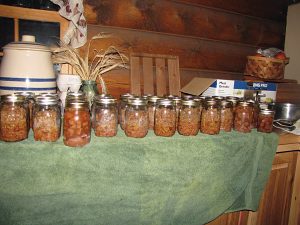
Once canned, meat will remain tasty for decades!
Dairy products should be used within a few days past their expiration dates because milk will sour and cheeses will mold, especially after having the containers opened.
It’s hard to determine the storage length of fruit. Some store-bought fruit has been picked very green and will rot before ripening. Generally, store-bought apples will last for at least a week on the counter or a month in the refrigerator. Peaches, plums, cherries, and nectarines can vary greatly, depending on how they were picked and treated. Hopefully, they will last a week or more in the fridge.
Most store-bought vegetables will stick around longer than fruits will. Potatoes, held in a cool, dark place (not in the refrigerator) will usually keep for several months. Carrots, kept in the bag in the crisper drawer of a fridge, will keep for at least a month, usually more.
Cauliflower and broccoli will discolor and become limp after several days in the fridge. Luckily, their cousin, the cabbage, will stick around a lot longer. Keep it wrapped in plastic and it should still be good weeks after being purchased.
Peas, fresh green beans, and salad greens usually only keep for several days in ideal conditions in your crisper drawer in the fridge.
Both bell peppers and hot peppers store pretty well in the fridge. You can expect them to stay fresh for at least a week and often two weeks or more, especially when kept in a sealed container.
Store-bought canned foods
Let’s take a look at the main reason people don’t want to chance eating “bad” food, which is food past the freshness date. The expiration date stamped on canned foods is simply a suggestion or a “best by” date. Initially, the freshness date was used for perishables such as milk, meat, and refrigerated foods, where it is an indicator of how long these foods remain fresh. Then it was added to canned groceries.
The good news is that the freshness date is not an indication of when canned foods start to go bad. In fact, nearly all store-bought canned goods, like home canned foods, will keep nearly indefinitely right on your pantry shelves. After the freshness date, the food still looks, smells, and tastes just like it did before that date. Unless the can has damage such as sharp dents, creases, poke holes, or rust spots, it should remain perfectly good for years.
How do I tell if my store-bought cans have gone bad?
You can tell if a store-bought can of food has gone bad if the can bulges out on the side, caused by gases formed due to decomposition inside, or if a can has rusted through. A can that spurts out liquid when opened should be discarded, as should one with food inside that either looks or smells bad.
If the can looks normal, opens normally, and the food inside looks and smells fine, your can of food is okay to heat and eat.
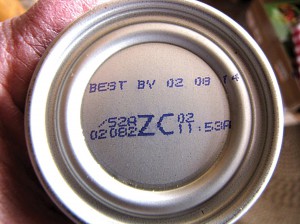
Nearly all packaged foods are dated with a “best by” date. With a few exceptions, canned and packaged foods remain good far beyond this suggested date.
Home-canned foods
All canned goods store best in a dry, cool, dark location. Moisture leads to rust, which is the most common cause of canned foods going bad. The rust eventually eats through the lid of the jar or can and lets in outside air, at which point the seal is gone and the food is no longer safe. A cool temperature will help canned food maintain its texture and flavor. A dark location is best because jars of home-canned foods sitting in intense light will become discolored — potatoes will darken, peaches will bleach out in color, corn will turn brown, and apples will often turn an unappetizing tannish-grey.
Like store-bought canned goods, all of your home-canned foods will remain edible for years if stored in cool, dark, and dry storage conditions. I still have some of the pie cherries I canned when my oldest son, Bill, was four. (He’s now 40!) And I can still make a cherry pie out of them that will knock your socks off. I have home-canned wild mushrooms from Montana that are 22 years in the jar and chiles from New Mexico that are 20 years old … both of which are perfect in every way.
Once canned according to approved methods, home-canned foods are one of the very best ways to ensure your family has tasty, nutritious food in your pantry for years and years. Let me stress the word “approved.” There are still folks who, despite warnings to the contrary, process their vegetables in a boiling water bath canner when they should be pressure-canned for safety. This is a huge error. While it’s true that our grandmothers did this, it has been found that Clostridium botulinum is not destroyed even with lengthy processing in a water bath canner. To kill the bacteria that causes botulism, a deadly form of food poisoning, all low-acid foods such as vegetables and meat must be pressure canned. Pressure canning processes the food at 240° F, and when foods are held at this temperature for the required amount of time, this dangerous bacteria and its toxins will be killed.
Jams and jellies that have been put up with paraffin, like Mom and I used to do often, will not last as long as when processed in a water bath canner. I used to use odd jars that didn’t accept bought canning jar lids to save myself money. I filled them with hot jam or jelly, then poured melted paraffin on top to seal the jars. This worked, until mice chewed through the paraffin. Then I started putting the used caps back over the paraffin. This helped the mouse problem, but sooner or later the paraffin would shrink away from the jar. Then air would get in because the lids were not sealed, and the jam or jelly would mold.
I learned my lesson and as the newer canning books instructed, I began using pint and half-pint canning jars to hold my preserves. I added a new lid and ring to each jar and processed them in a boiling water bath. Now my jams and jellies last for decades with absolutely no mold, fermenting, or mouse damage.
If you don’t process your home-canned foods correctly, don’t expect them to safely store on your pantry shelves for years. Buy a good canning book, such as Growing and Canning Your Own Food, then read the directions every single time you can food. I still do, and I’ve been canning for more than 50 years.
How to tell if your home-canned foods have spoiled
First of all, let me repeat now: If you have used approved canning methods and have followed directions, there is very little chance that your food will ever spoil during storage. This includes meats, fish, vegetables, fruits, pickles, jams, jellies, and much more.
But there is always a chance that a lid’s seal will fail during storage, causing the food to spoil. This usually happens because a small piece of food has blown up onto the rim of the jar during processing. The lid will apparently seal, but during storage, the seal fails and the food spoils.
Here are common signs that your home-canned food has gone bad: severe discoloration or darkening of light foods, the seal of the jar has failed (instead of being firmly indented, the center of the lid can be pushed down with a finger), the food looks nasty, there is a foul smell upon opening the jar, there is mold on the food, or there is unusual sediment in the bottom of the jar.
Sometimes there are black deposits on the underside of the jar lid. This does not mean that the food has spoiled; it is just a chemical reaction and the food is still fine.
Even if the food seems fine, always bring each jar of pressure-canned food up to boiling temperature (210° F) for 10-15 minutes (depending on altitude; higher altitudes require more time) before eating. This may be done by boiling, baking, or frying, as each recipe requires. This will kill nearly all harmful toxins, bacteria, molds, and yeasts that might not have been discovered when opening the jar.
Frozen foods
While I can much of our food, I sometimes hold some in the freezer until I get around to canning it up. The reason I do can up most of our food is that once in the jar, it is good nearly forever. Unfortunately, frozen food does not remain good that long; usually about a year is tops. And then there’s always the threat of the freezer dying or the power (if you’ve got it) going out unexpectedly. This happened to me years ago, and I still remember the shock when I discovered our full freezer melting down! I spent 48 hours straight canning madly as the food went soft. I did get a large part of it canned up and saved, but we ended up carrying a lot of vegetables and fruit out to the pigs.
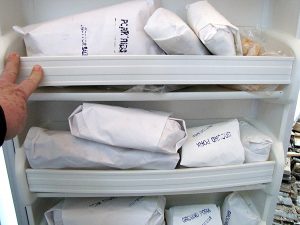
Well-packaged frozen meats, such as our home-raised pork, will remain good for more than a year.
It’s true, freezing food is quick and easy. But canning is more sure!
Keeping food for a longer time in the freezer often depends on how well you packaged it in the first place. If you just toss the store-packaged item in the freezer, you can count on less storage time than if you re-pack or additionally wrap a food. Air is the enemy of frozen food. Seal out the air and your food will keep much longer. Freezer burn is the result of air getting to your food. This causes white spots on meat and unappetizing flavors that you can’t mask with seasonings or spices.
Here is a basic chart for the common recommended length of storage in a freezer at 0° F, which is the recommended temperature to maintain frozen foods:
If you take the time to double-wrap your meat or vacuum-seal your foods, you will more than double the life expectancy of frozen foods.
Stored garden produce
Some garden produce will only keep a short while, such as lettuce. Other produce will keep well for many months if given ideal storage conditions.
It is nice to have a root cellar in which to store your harvested fruits and vegetables. If kept cool with the proper humidity, foods will remain garden fresh for much longer than if kept at room temperature in a back closet. But not everyone has a root cellar or the means to build one. We have had great success storing food, regardless of where we lived, by using a little common sense.
Here on our homestead in northern Minnesota, we keep our potatoes, fruit, carrots, turnips, rutabagas, and cabbages in a corner room of our unheated basement. The temperature all fall and winter remains between 40-50° F. In the summer, the temperature rises to about 50-55° F. Our root crops stay crisp until our next fall harvest.
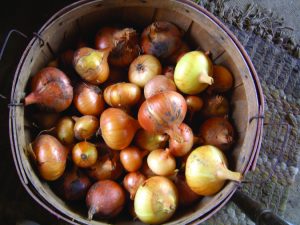
Potatoes and other root crops store for many months (up to a year for potatoes) in covered plastic totes down in our unheated root cellar. A good storage variety of onion will store well over winter when kept in baskets or net bags in a cool, dark area.
When I lived in New Mexico, we didn’t have a basement. We kept root crops in the ground until freezing weather hit, then stored them in an unheated walk-in closet in the spare bedroom. We kept the door closed except when we brought out something for dinner. The temperature remained between 35-40° F. As the spring temperatures warmed, so did our closet. By June it was around 60° F, and our food storage was about done for the year. The potatoes and root crops were getting wrinkled and sprouting. My mom kept her harvest in an unused small bathroom with air conditioning and a sealed, insulated window. Her crops lasted much longer than mine did.
If you have a heated basement, you can make a small room in a corner that is away from the heat and use insulation in the walls to keep the warmth out. Adding a vent via a window that can be opened to the outside will also help keep the “root cellar” cool. (Don’t let it get below 34° F, or your crops may freeze.)
It’s a common misconception that squash and pumpkins need to be kept cold. For years I hauled mine down to our basement or piled them in unheated areas of the house, only to carry the soft, rotting squash/pumpkins out to the pigs and chickens after only a few months. Then, by accident, I found that both pumpkins and squash love being stored at room temperature! I’ve had both squash and pumpkins last well over a full year when simply stored in an out-of-the-way area of our living space.
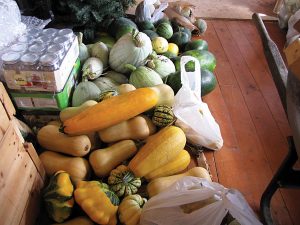
Squash and pumpkins remain good for months, even years, when stored out of the sun in regular household temperatures.
If properly stored in cool temperatures with plenty of humidity, all root crops can last well through the winter and spring. We store ours in plastic totes in our pantry/root cellar where there is no outside light. Any light whatsoever will cause potatoes to start sprouting and other crops to start growing roots and leaves.
Apples, when stored in proper conditions, will keep until about May or June, depending on the variety. A winter apple, kept at a temperature of about 32-33° F in very high humidity (90-99%) will remain solid and tasty well into spring. But if you store the same apple at 50° F, you will shorten its storage capability to less than half the time.
Summer apples simply won’t store much past a month, no matter what the storage conditions are.
Pears do not store nearly as well as apples. Even with proper storage conditions, such as required for apples, pears will seldom store longer than two to three months.
Peaches, nectarines, and cherries store even more poorly than pears, so simply refrigerate small amounts and freeze or can up the rest.
Eggs
When our chickens are in peak production in the spring and early summer, it seems like we’re flooded with eggs. It’s then I make plenty of egg salad, deviled eggs, pies, and pastries with plenty of big meringues, cookies, and custard pies.
Unfortunately, you can’t can eggs (other than pickling them).
You can freeze the inside contents of eggs and they’ll remain good for about 12 months if sealed against the air. To freeze whole eggs, simply mix the contents of the egg by pressing through a sieve and packing into freezer containers, leaving ½ inch headspace.
Or you can separate the eggs and pack whites in one container and yolks in another. Be very careful not to add air bubbles. Remember, air is the enemy of frozen food storage! Separate the eggs and to each six yolks, add 1 tsp. sugar or ½ tsp. salt so they don’t get tough. Press the yolks through a sieve to mix without adding air bubbles, then pack as you did for whole eggs.
When you want to use the frozen eggs, thaw them, then use. Two Tbsp. whole eggs are equivalent to 1 egg in a recipe; 2 Tbsp. egg whites are equivalent to 1 egg white; and 1 Tbsp. egg yolk is equivalent to 1 egg yolk.
Folks have asked me for years and years how to store fresh eggs for long-term storage. I’ve submerged eggs in waterglass, which is sodium silicate mixed with water, in a crock for storage over winter. It works, but it is really nasty, reaching deep into a cold crock and getting cold slime on your hand and arm every time you want an egg! And the funny thing is that since then, I’ve simply stored cartons of fresh eggs down in our unheated pantry, all winter, with no preparation at all! You must be sure the eggs are not cracked or they’ll spoil.
(Did you know that “fresh” store-bought eggs can be up to several months old before you buy them?)
Dry foods
Dry foods such as flour, sugar, rice, beans, and pasta are very easy to store long-term with very little preparation. Where some folks take the time to “oven can” jars of these foods, I store all of our dry foods without special treatment. I just put the original plastic or paper bags inside a gasketed plastic pail and shut the lid. This keeps out all moisture, insects, and dampness. Some of the foods I store this way are: brown, confectioners’, and white sugar; split peas, lentils, dry beans (such as navy, pinto, and kidney), chocolate chips, shredded coconut, white rice, and pastas. Larger bags containing dry foods are stored in the original packaging, inside plastic garbage cans. These foods include unbleached flour, 50 lb. bags of popcorn, wheat, rye, dry milk, and rice. Mice and rats can chew through plastic garbage cans, so metal cans are best.
So how long do these foods store like this? The answer is simple: pretty much forever! As long as they remain dry and undamaged by insects or rodents, these supplies remain tasty and useful for decades!
Exceptions to this are whole-grain foods such as whole wheat flour, brown rice, and whole cornmeal (that hasn’t been degerminated). These foods will only keep for a few months at tops without going rancid. To make them last longer, store in the freezer. Because we live off grid and don’t keep a freezer running indefinitely, we store wheat, rye, and corn whole and grind it only as I need it, a few weeks’ worth at a time. Brown rice must either be kept in the refrigerator or in an unheated location during our long Minnesota winter to store for months at a time.
Nuts, in the shell, will often store for years without becoming rancid. Once they are shelled, they will only last for several months. This is why I can almost all of my shelled nuts. It is very quick and easy. These canned nuts will last for decades without getting rancid. To can nutmeats, all you need to do is to spread them out on a cookie sheet in the oven and turn the temperature to 250° F for about 30 minutes, stirring occasionally to keep them from scorching. Fill dry, sterilized pint or half-pint jars with hot nutmeats, leaving 1 inch headspace. Cap with hot, previously-simmered lid and screw down ring firmly tight. Pressure can at 5 pounds pressure for 10 minutes. If you live at an altitude above 1,000 feet, consult your canning book for directions on increasing the pressure to suit your altitude.
If you have had trouble with pantry moths in your dry foods, you can freeze your food for several days before storage to kill the moths. Another treatment is to heat your dry food in the oven between 110-150° F for 15 minutes. (Don’t heat it at higher temperature, or it will destroy some of the nutrients in the food.) Or you can treat buckets of dry food with dry ice by adding ¼ pound of dry ice, placed on a piece of brown paper bag, on top of the food, closing the lid to allow some air to escape, then waiting half an hour. Peek to make sure all of the dry ice has evaporated. If not, close the lid and wait another 5 minutes. When it has evaporated, remove the paper and seal the bucket.
Any dry food can become infested with grain-eating insects such as the Indian meal moth or flour beetle if the container it is stored in is not airtight. These insects can crawl through amazingly small cracks! Signs of meal moth or pantry moth infestation are webbing inside the container and small “worms” in the food. Other insects are detected by the presence of bugs in the grain.
These insects commonly infest flour, cornmeal, cereals, and bird seed, but they can also infest rice, dry milk, dry pet foods, dried fruits and vegetables, and dry oatmeal.
Treating and protecting dry foods from these pests is easy and cheap, making your long-term storage pantry safe and effective.
Mixes and pre-packaged foods
There are a lot of different mixes and pre-packaged foods at your local grocery store. Some store well; others not so long. Generally, the foods with fat added store less well than those that do not contain fat or oil. One brand that is notorious for not storing well is Bisquick.
I’ve had very good luck keeping cake mixes for a year or more, and complete pancake mixes for longer than that. Once opened, these mixes should be used quickly, so make sure to store them in the original package.
An easy fix to keeping mixes for long-term storage is to make your own. Simply mix up a big batch of your favorite mix and omit the shortening, butter, or oil.
One thing to remember when storing foods that are pre-packaged “instant” meals like Hamburger Helper: For what they are, they are very expensive! You can do better yourself and the results will taste great and store much longer. Plain pasta and rice mixed with home-canned or dehydrated foods make a great meal from scratch.
Spices
It is commonly said that spices only last for a year and then they lose flavor and should be tossed out. This is okay for chefs, but for common cooks like me, spices are great for years — provided they are kept in an airtight container. I’m sure it’s true that fresh spices add more flavor per pinch than old spices do. But if I’m using older spices, I am just careful to taste along the way and add more if needed.
Oils and shortening
Oils such as vegetable, corn, canola, peanut, and olive oil will remain fresh tasting for years in most cases if they are left unopened. Once opened and exposed to both air and warmer kitchen temperatures, all can go rancid quite quickly. Most of the time, however, oils will remain good in the kitchen for at least several months, longer if kept in the refrigerator. Oils are one of the things in my storage pantry that I buy in smaller bottles. True, it’s cheaper to buy large bottles. But if you don’t really use that much oil in a month or two, the remainder can go rancid and you’ll end up tossing it out. I’d rather pay a little bit more and not have any go rancid.
Shortening is another fat that is handy in the pantry. Unopened cans will last for many years. Once opened, however, the shortening will eventually turn rancid. To lengthen the time it remains good, keep refrigerated once opened or store in a very cool place. Opened cans of shortening should get the “sniff test” before each use. If it smells okay, it’s fine to use.
Dehydrated foods
Dehydrated foods, like dry food supplies, last for decades with minimal care and no pre-treatment. Whether you stock your pantry shelves with home-dehydrated foods, store-bought dehydrated foods, or purchased preparedness foods, be assured that they will last for years and years.
We have many foods in our pantry that I dehydrate in my kitchen all year long. These include blueberries, raspberries, strawberries, apples, plums, diced carrots, sliced and powdered onions, citrus powder, diced peppers, sliced potatoes, peas, corn and parched corn, jerky, sliced tomatoes, and more. I buy raisins, dehydrated cherries, cranberries, and dates at the store. I buy dehydrated eggs, cheese powder, bacon or taco-flavored TVPs (textured vegetable proteins), powdered sour cream, and shortening from preparedness companies.
Dehydrated fruits and vegetables, when properly dried and stored in a cool, dark, and dry location in an airtight container, last indefinitely. Likewise, so will most preparedness foods, bought in #10 cans, although the “recommended” shelf life is said to be only about 15 years. To lengthen the storage life of all dehydrated foods, keep them cool! Foods stored in temperatures of 80° F store for only a few years; at 40° F they’ll store for several decades.
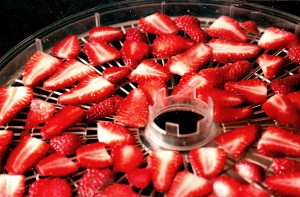
Home-dehydrated foods, such as these strawberries, stay tasty in airtight containers for decades.
I store all of our home-dehydrated fruits and vegetables in sealed glass jars down in our pantry, in our unheated basement. Store-bought dehydrated fruits are kept in their original bags inside of gasketed plastic buckets in the same basement. My preparedness foods remain in their cans on my pantry shelves until they are opened. Once opened, I move them to my kitchen and use them until they are gone.
One dehydrated food requires special consideration: home-dehydrated jerky. In the old days, jerky was made to store. It was dried to the texture of a stick — very hard and brittle. Today’s commercial jerky remains soft and chewy due to chemical preservatives. Home-dehydrated jerky should be stored in the refrigerator to prevent mold. Dry it down past the “leathery” stage, right to the hard-as-a-stick stage of dryness. If this is done, jerky will remain good in an airtight container for months or even longer. (It never lasts that long around here!)
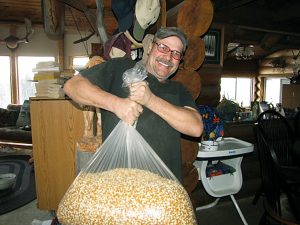
After most of our sweet corn has been eaten or canned, I let the rest mature on the stalk. Here’s Will with a big bag of shelled dry corn ready to go into airtight storage containers to be ground for cornmeal later. It will remain good for years!
Yeast and leavening agents
Yeast is essential for baking breads and rolls. Unfortunately, it does not remain good for long. And as it weakens, the breads lose their nice puffy rise and pretty soon you’re taking dense, flat loaves out of the oven. I buy my yeast by the pound, locally or from a preparedness company. By keeping a pint jar of that yeast in the refrigerator and a pint jar in the freezer, I’m assured of yeast for at least a year. In the refrigerator, it will keep for at least a year, while frozen yeast keeps for several years (recommendations vary from 5 to 15 years). One thing I’ve learned is that if you buy vacuum-sealed bulk yeast in one-pound packages (the ones that feel like a brick!), then freeze them, they seem to last indefinitely. On the shelf, unopened, I’ve found they remain good for several years. You do not need to bring yeast up to room temperature to use it in a recipe.
Other leavening agents such as baking powder and baking soda have very long shelf lives, especially before being opened. You can expect them to last for decades in your pantry, then for several years on your kitchen shelf. But you should rotate them because they will lose their leavening ability and your baked goods will slowly become flatter and flatter until you are not getting compliments on your baked goods anymore. Of the two, baking powder will “go” first, years before baking soda. Always store both of these where moisture is not a problem. Storing them in a cool, dark location will make them last much longer than storing them in a sunny window.
Salt
Table salt will remain good indefinitely. However, after long-term storage it will often get hard in the box. Therefore, it is best to pour your salt out of the box, into a sealed, dry container for long-term storage.
If your salt should get hard, don’t throw it out. Place it in a clean, old pillowcase and work it over with a hammer or rolling pin. Then press the particles through a sieve. The old treatment of placing a few grains of white rice in a salt shaker does wonders for keeping the salt from getting chunks or setting up in a salt shaker.
Rotating your food to keep it fresh and tasty
No matter what foods you store, no matter how you store it, food should always be continually rotated to keep using the oldest food first. No matter how you store your food, it will eventually lose some nutrition, taste, and appearance.
Some storage methods require more frequent rotation. For instance, vegetables and fruits in your root cellar or basement need to be eaten relatively soon to avoid spoilage and waste. After I’ve stored these foods for several months, I begin canning and dehydrating some of them so that I don’t end up hauling buckets of softened or spoiled food out to the chickens and pigs, come spring.
Most frozen vegetables and fruits can be dehydrated. So if it’s nearing the end of their storage life, consider dehydrating them. Some can also be canned. Vegetables, especially, are easily thawed, heated, and then home canned for extended storage. Any loss of food is depressing and avoidable.
My home-canned foods are easily rotated by sliding the older jars to one side and filling the “slot” next to them with newly-canned foods. The older foods are then moved to the front of the new jars and are used first. Ideally a person should mark the lids of the jars with the date they were canned. I don’t ever get around to that but do make sure my “old” jars sit right at the front of the shelves so they get used first.
Many people stock up their pantry with long-term food storage items and just let them sit there, year after year, “in case some emergency befalls us.” This is a bad idea. Often these foods are based on whole grains, beans, legumes, and pasta. And if they don’t frequently cook with them, they don’t know what to do with these foods should some emergency happen.
It is very important that a family regularly uses some of their emergency preparedness foods in everyday family meals. I have done this for more than 40 years and my family doesn’t know the difference between “emergency foods” and regular, everyday meals. By using these foods regularly, you can easily rotate them, using the oldest foods first so they always maintain great taste, nutrition, and visual appeal.
There will be those of you who read this article and rear up in indignation saying, “I read on the internet … ” or “my home economist says … ” refuting the common sense of this article. I based this piece on my own experience of more than half a century of storing food, and also on the experience of hundreds of self-reliant folks that I talk to every single year. I hope you’ll stock up your pantry with plenty of food and not be scared off by marketing ploys, but instead will rely on your own experiences in storing food long-term.

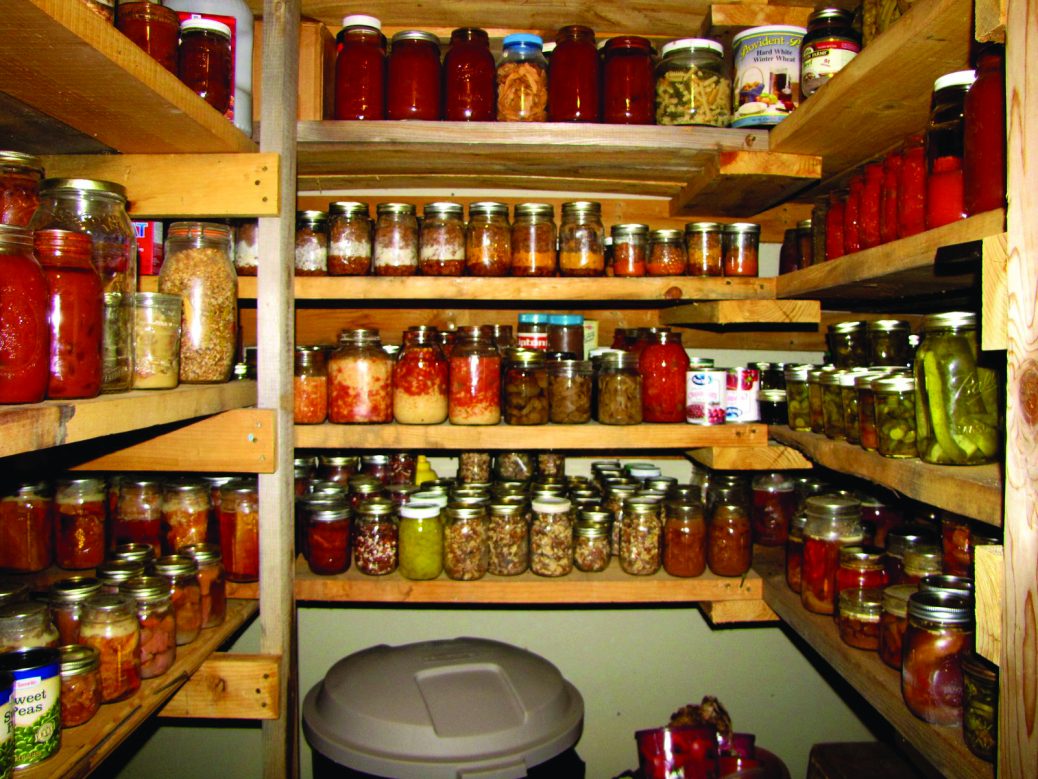
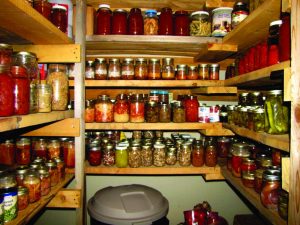
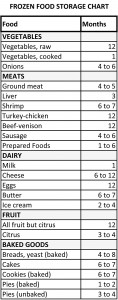
I would like to know when I put my flour, rice & noodles in canisters they get a strange smell in them after a while? Is it the original packages I leave them in ? Or is it just the canisters?
Jackie, you have inspired me over the years. Your growing and canning book is the one I reach for every time I can. I live in CO at 7200 feet and can at 14 & 1/2# pressure. We recently ate a quarter of peaches I canned in 2001 – boy were they good! Thanks for helping me to expand my canning past the usual veggies, fruit & meats…I have done bacon, cheese, nuts, butter, etc following your instructions.
PS I oil my eggs with mineral oil & they last for 6 months.
I buy flour when it goes on sale in quantity. A number of years ago I had a number of bags start crawling with weevils. Now as a matter of course I vacuum seal the bags and freeze for 72 hours, which ruptures any eggs laid in the flour killing the bugs. One thing you need to do is before opening let the flour come to room temperature before opening. Condensation bad.
No more bug issues.
Thanks for the article.
Thank you for all the information. I dry and store as well, but not done some of the things you suggested., going to try Mylar bags this year for mixing soup stuff for 10 servings. Have you used them?
We live in Colo. 6800 feet so am limited for storage of canning products. I dry cooked pintos and other beans, vegetables then grind into powder, this makes a great hot drink in afternoon, I add bouillon or beef broth for extra flavor.
Thanks again you have inspired me.
Could I get recipe and instructions for canning cabbage rolls please. Thank you. Betty